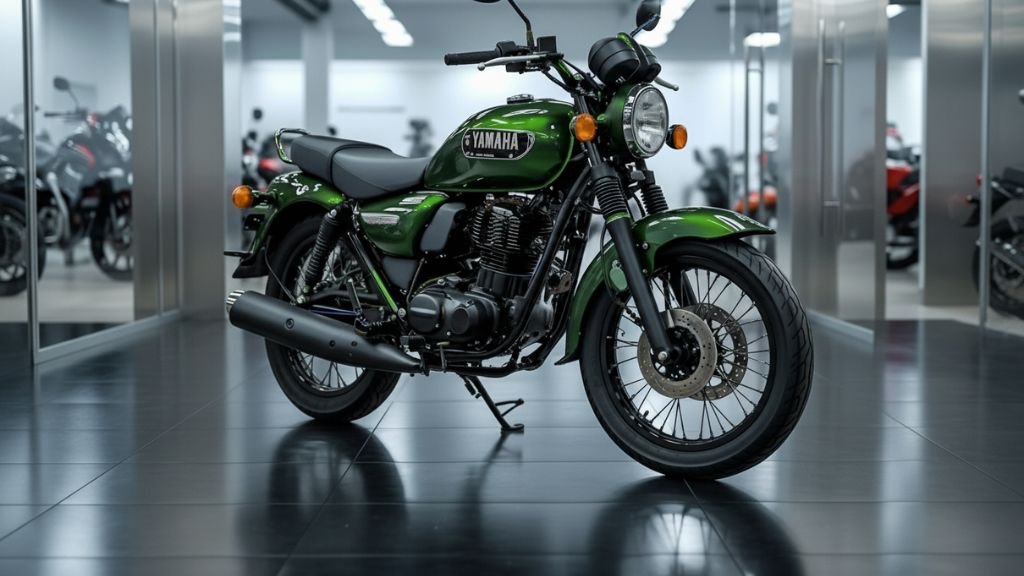Yamaha RX100 : If you ever whispered “oh I wish the Yamaha RX100 would come back,” Yamaha seems to have heard you loud and clear. The Yamaha RX100 2025 relaunch is more than nostalgia. It’s a bold statement: the legend can live again, built to modern rules, fueled by both emotion and engineering.
The rumour mills and leaks are simmering with possibilities—200cc power, retro styling that winks at the past, and feature upgrades just enough to make today’s roads feel new again. Let’s ride Yamaha RX100 through what we know, what we hope, and what this reborn legend might really deliver.
A Walk Down Memory Lane
To many Indian riders, the name Yamaha RX100 isn’t just a model—it’s a memory. Born in the mid-1980s, this two-stroke icon burned rubber and hearts alike with its peppy acceleration, unmistakable exhaust note, and light, agile handling.
Yamaha RX100 became not just a commuter but a rite of passage: college runs, spirited weekend rides, street races. Even decades after its discontinuation, it holds a cult status among motorcycling fans, classic bike lovers, and those who chase a visceral feel rather than digital dashboards and app integrations.
That legacy is exactly what Yamaha is betting on with the 2025 relaunch. But legacy without relevance is just a museum piece. So the challenge—and opportunity—lies in preserving the soul of the RX100 while giving it a body and spirit that modern riders can actually live with.
What The Rumours Say
The biggest twist in all the chatter is the possibility of 200cc power. That’s a big Yamaha RX100 leap from the original’s ~100cc two-stroke heart. While no official spec sheet has confirmed it yet, insiders suggest Yamaha may move to a four-stroke, high-efficiency engine in the 150–200cc range to balance modern emission norms and spirited performance. Some leaks talk of a 125cc or 150cc upgrade too, but fans are pushing 200cc as the aspirational sweet spot.
Styling will be a major conversation. Expect the classic teardrop fuel tank, chrome mirrors, a round headlamp revisited with LED innards, and a slim fuel tank line that nods to the old days.
But modern Yamaha RX100 touches like LED indicators, a semi-digital instrument display, disc brakes (possibly ABS), and refined suspension are almost certain inclusions. The challenge will be in balance: too many changes and it loses the soul; too few, and it’s underwhelming for 2025 roads.
Performance
If Yamaha pushes ahead with 200cc, this reborn RX100 should feel exhilarating but manageable. A modern four-stroke engine tuned for both city poke and occasional bursts should allow the bike to deliver strong midrange torque (ideal for Indian traffic), without sacrificing fuel efficiency.
Expect power figures in the range of 12–18 bhp (if Yamaha RX100 plays it safe) or more if they go aggressive. Suspension upgrades—telescopic forks up front, perhaps a rear monoshock or upgraded twin shocks—will tame uneven roads.
Braking would ideally step up to discs, maybe even single-channel ABS to keep things safe without overcomplicating the charm. The weight will be crucial; if Yamaha can keep it light—say, under 140 kg or so—it will retain the flickability that made the original Yamaha RX100 an urban legend.
Design and Detailing
What sells this relaunch is how it looks and feels. Yamaha would (and likely will) lean heavily into nostalgia: curved shapes, chrome bits, classic fonts, and color schemes that evoke a decade or two ago. But it also must resist the trap of turning into a costume. That means subtle modern touches: LED lighting hidden in classic housings, clean minimal bodywork, subtle badges, and a digital cluster that doesn’t scream “gadget.”
Many believe the Yamaha RX100 will merge that classic silhouette with modern ergonomics: slightly more space, better pillion support, slightly revised geometry for comfort over long rides. Some leaks already mention LED headlamps, sleek lines, and a minimalist look but with a modern twist.
Real-World Use
Ride comfort will be where Yamaha earns respect or regrets. The original RX was raw and direct—fun on smooth roads, tricky on broken ones. The new iteration must be compliant without being mushy. Suspension should soak bumps, frame geometry should preserve nimble cornering, and ergonomics should allow upright yet spirited posture.
City riding will likely be the home ground for this bike—stop-start traffic, tight turns, short bursts. That’s where the Yamaha RX100 heritage shines. But for the design to carry weight, highway behavior must be confident enough to handle 80–100 km/h comfortably—vibration, wind buffeting, stability all under control.
Competition and Market Position
In 2025, the RX100 won’t have many direct rivals in the retro performance niche. Modern street bikes in 125cc–150cc range already exist (Hero, TVS, Bajaj etc.), but few carry legacy weight or retro style so intentionally.
That gives Yamaha space to position the RX100 not just as a motorcycle, but as a lifestyle—the aspirational throwback with usable performance.
From what leaks suggest, the pricing will be premium. Because this is no longer a mass commuter; it’s a style statement and a piece of heritage.
To win over buyers, Yamaha must prove the value is more than nostalgia—every modern rider will expect features, reliability, service network, and parts availability.
The Risks & Watchouts
- Emission Regulations: Two-strokes are dead in modern India. Yamaha must adopt a clean four-stroke architecture to survive.
- Weight Creep: As modern parts pile in (ABS, stronger frame, electronics), the bike could get heavy. Too much weight and you lose what made RX100 special.
- Vibrations & Refinement: Old RX100 style included vibration in its character. New buyers may expect refinement. Taming harsh vibes without removing soul is tricky.
- Spare Parts & Maintenance: Since original RX100 parts are rare now, Yamaha must commit to parts support in new avatar.
- Pricing Overreach: If the bike becomes too expensive, it turns into a collector’s toy rather than a rider’s machine.
Why Riders & Enthusiasts Are Already Humming
Because the RX100 has emotional resonance. It’s not just a bike—it’s memories, youth, rebellion, friendship. Its return offers a chance to ride a legend in today’s world. The 2025 relaunch lets new riders taste classic motorcycling. It’s a bridge between eras, a statement of what motorcycling felt like before screens and apps took over.
What We Wish Yamaha Does
- Keep it light—don’t let modern parts bulk it up too much.
- Smartly modernize—add ABS, LED, semi-digital dash, but keep design language clean.
- Support & servicing—wide dealer backup, affordable spares, warranty.
- Variants—maybe a stripped-down “heritage” and a full-feature “premium” model to widen appeal.
- Color and limited editions—classic shades, special runs to keep interest.
Final Thoughts
What Yamaha is attempting is bold. The Yamaha RX100 2025 is not just a relaunch of a name; it’s a test of whether nostalgia can survive in a modern package. If Yamaha gets the balance right—heritage look, modern spec, rideable feel—this could be more than a revival. It could be a new classic, the kind of bike talked about decades hence. For lovers of the original, it’s a dream come true. For new riders, it’s a chance to ride history—not just admire it. Time (and roads) will tell, but the legend is already back.
Frequently Asked Questions (FAQs) About The Yamaha RX100 2025
Q. Will the 2025 Yamaha RX100 keep the original two-stroke engine?
No. That’s not possible under modern emission and noise norms. The relaunch must use a four-stroke engine, likely upgraded to around 125–200cc, to comply with current standards. Rumours point to a powerplant that balances modern efficiency with spirited performance.
Q. When is the Yamaha RX100 2025 expected to launch?
Timelines are speculative. Some reports initially predicted a 2025 release, but later news suggests a delay to December 2026 to align with regulatory preparations and production readiness.
Q. What kind of mileage or fuel efficiency will the new RX100 offer?
Early leaks suggest mileage estimates might fall around 35–45 kmpl in real-world riding. Because of higher power and features, expect it to vary with riding style and traffic.
Q. Will it have modern safety and features like ABS, LED lighting, digital display?
Yes, most likely. Rumours strongly indicate LED headlamps/indicators, semi-digital (analog + digital) instrumentation, disc brakes with (at least) ABS or CBS, and possibly Bluetooth connectivity for notifications.
Q. How much will the Yamaha RX100 2025 cost?
No confirmed price yet. Speculation places it in the premium segment, possibly between ₹1,20,000 to ₹1,50,000 or more depending on features.
Q. Is this bike meant for long rides or city use?
It’s likely optimized for city and short highway use—daily commuting, twisty roads, weekend runs. For long touring, its engine size, comfort, and fuel tank will be tested—but for many, that nostalgic connection is the priority.
Q. Will spare parts and servicing be easy to get?
Yamaha will need to commit to a strong aftermarket and dealer support. For a relaunch like this to succeed, parts availability, warranty, and service network are musts. That’s an area where Yamaha should win hearts again.
Q. Who will be the ideal buyer for this RX100 2025?
Retro lovers, nostalgia seekers, younger riders wanting heritage feel, those who want style without fully abandoning modern standards. It’s not for someone who wants only specs; it’s for those who ride with emotion.
If you like, I can also prepare a teaser post or social version of this article or even compare the 2025 RX100 vs its old version. Just say the word.



